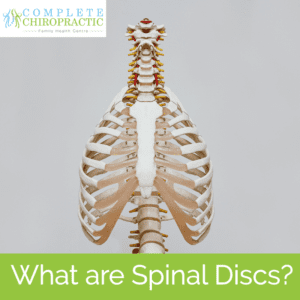As a Chiropractor, we spend the vast majority of our time working with Vertebra and Spinal Discs – most people have heard of the vertebra, but often we’re not so sure on discs! We all have discs – but what exactly are they, and how can they cause us problems?
What are Spinal Discs?
As I’m sure you know, your spine isn’t a single bone – it’s not even close – Your spinal column has 24 moveable bones which support the rest of your body. Between each of these vertebra, you’ find a spinal disc. Each disc basically acts like a small swivel to allow your body to tilt and rotate – without the discs, you’d be totally stiff. Perhaps you can already see where the problems can come in!
So, what is a disc made of? – A disc is mostly made up of water, and that high water content helps keep it supple and moveable. Each disc is comprised of a tough, fibrous outer layer (annulus fibrosis) and a jelly-like inner layer (nucleus pulposus). The tough outer layer contains and protects the softer inside layer and gives it form.[1]
Common problems
The most common problem with discs is an increase in stiffness. Discs, like the rest of the body, suffer from wear and tear as you get older. Over time, your discs tend to lose their high water content, which can lead to degeneration, and as you might imagine, degenerative discs don’t move as well, are more prone to cause pain, and even contribute to the compression of your spinal nerves.
A more serious, and still fairly common problem is called a bulge or herniation – it’s an injury which most commonly occurs between 45-65 years of age when discs are naturally more dehydrated and stiffer.
In short, a disc bulge or herniation occurs when a disc’s inner portion is trying to (or has) pushed through its tough outer layer.
When this happens, it can cause pain in two different ways.
- If the disc bulges far enough to press on a spinal nerve, you may notice pain that travels down your arms or legs.
- If the inside of your disc pushes through the outer layer, it could also cause severe inflammation resulting in pain.
How can we treat disc problems?
The best way to treat disc problems is to prevent them from occurring in the first place, and thankfully that’s simple to do. Movement is, in fact, one of the best ways to keep your spinal discs healthy. Since the spinal discs don’t have a particularly good blood supply, movement is how they bring in nutrients. Those nutrients help the discs stay healthy and push out waste that can contribute to pain and inflammation.
Chiropractic is an excellent way to gently “move” the discs, in fact you can think of it as an effective way of increasing blood flow and flushing out toxins.
Where injury has already occurred, the good news is that your spine is incredibly resilient – it has to be, since it’s job is to support the whole body. Research has again proven that movement-based care, such as spinal adjustments and spinal rehab, are incredibly effective at helping you heal from spinal disc injuries[2]. In fact, exercises that “centralize” your spinal disc may be able to prevent future episodes of sciatica.
If you need help with painful spinal discs, or have sciatica or spinal pain – get in touch, we can help!
[1] Intervertebral Disc: Anatomy-Physiology – Pathophysiology -Treatment. Pain Practice. 2000.
[2] Bulging Disc vs. Herniated Disc: What’s the Difference? Mayo Clinic. 2019.
Exercise for Sciatica from a Herniated Disc. Spine-Health. 2019.

